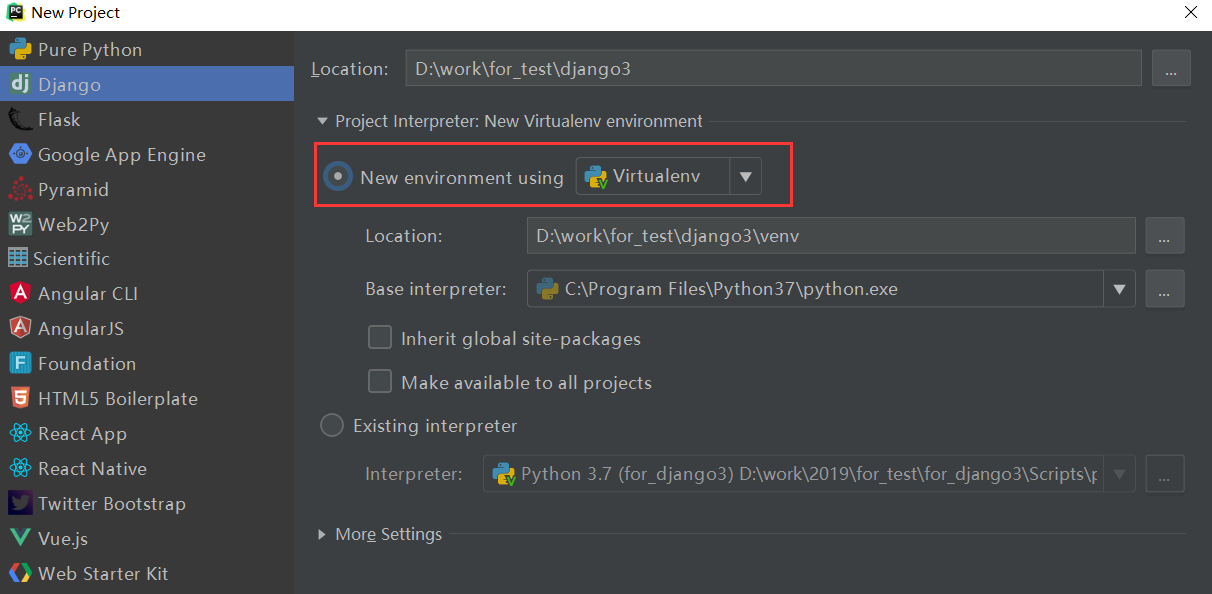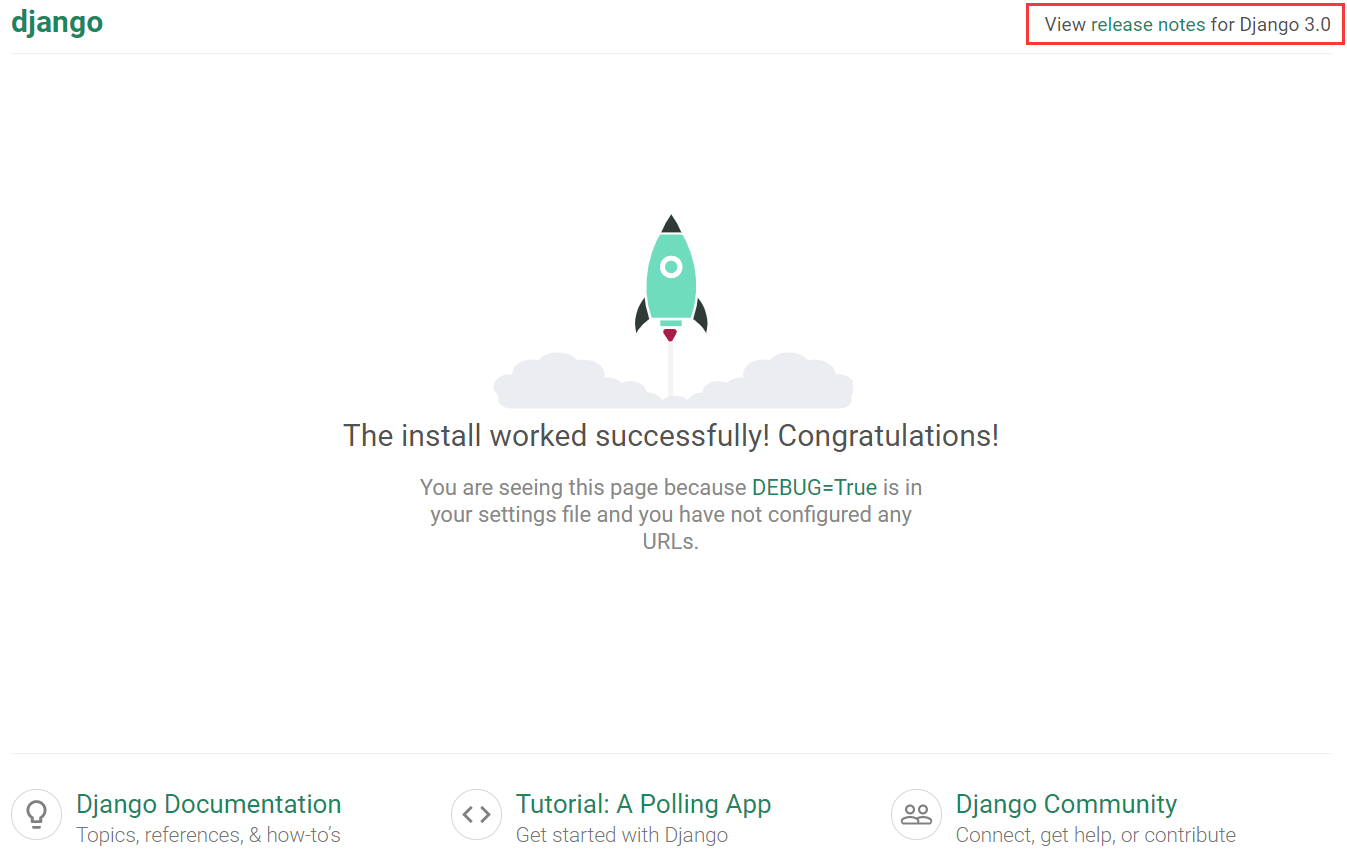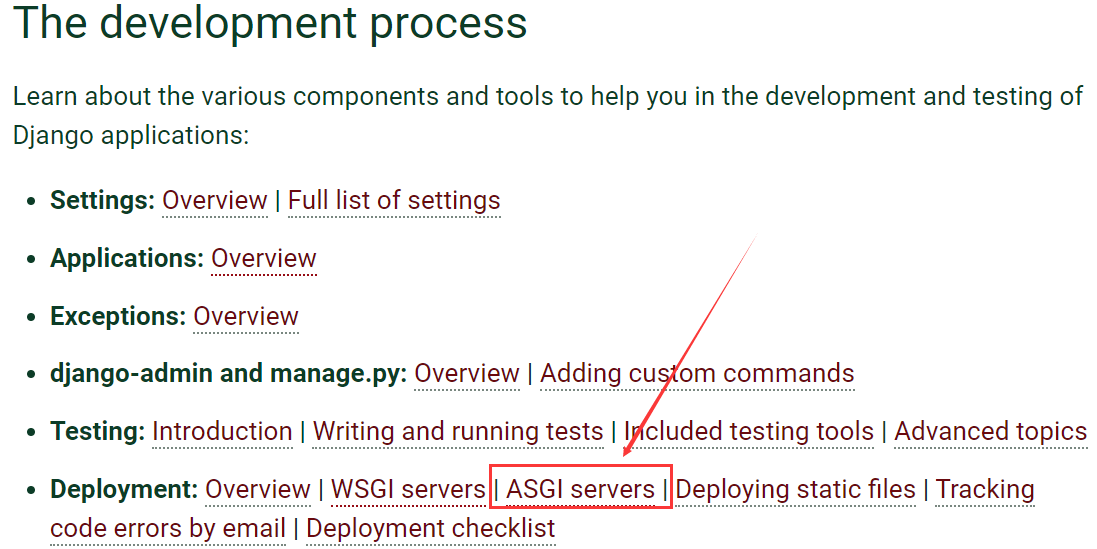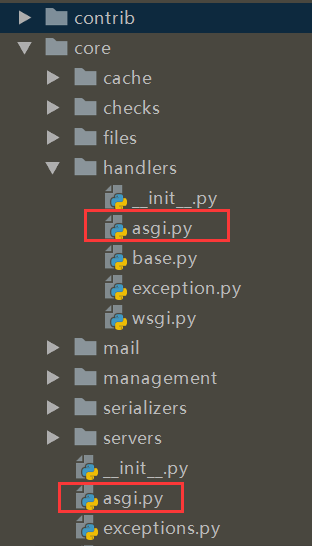此前博主曾经写过一篇博文,介绍了Django3.0的新特性,其中最主要的就是加入对ASGI的支持,实现全双工的异步通信。
(更多Django的教程和博客,可以访问我的官网http://www.liujiangblog.com,或者收藏我的微信公众号‘Django之家’。)
(更多Django的教程和博客,可以访问我的官网http://www.liujiangblog.com,或者收藏我的微信公众号‘Django之家’。)
2019年12月2日,Django终于正式发布了3.0版本。怀着无比的期待,我们来尝试一下吧!
(附ASGI官方文档地址:https://asgi.readthedocs.io/en/latest/extensions.html)
一、创建Django3工程
利用Pycharm的方便,直接通过virtualenv创建虚拟环境,并安装Django3.0。
打开控制台,看看都安装了哪些库:
(venv) D:\work\for_test\django3>pip listPackage Version------asgiref 3.2.3Django 3.0pip 10.0.1pytz 2019.3setuptools 39.1.0sqlparse 0.3.0除了pytz和sqlparse,又自动安装了asgiref。
asigref由Django软件基金会开发和维护,是一个Django生态中的库。
先启动一下服务器,看看Django是否正常运行:

没毛病,可以把服务器关了!
二、学习官方文档毕竟是非常重要和复杂的新特性,先到官网取取经,看看文档怎么写的。
找了一圈,What?就这么点东西?

先康康吧。
(更多Django的教程和博客,可以访问我的官网http://www.liujiangblog.com,或者收藏我的微信公众号‘Django之家’。)
How to deploy with ASGIAs well as WSGI, Django also supports deploying on ASGI, the emerging Python standard for asynchronous web servers and applications.Django’s startproject management command sets up a default ASGI configuration for you, which you can tweak as needed for your project, and direct any ASGI-compliant application server to use.Django includes getting-started documentation for the following ASGI servers:How to use Django with DaphneHow to use Django with UvicornThe application objectLike WSGI, ASGI has you supply an application callable which the application server uses to communicate with your code. It’s commonly provided as an object named application in a Python module accessible to the server.The startproject command creates a file <project_name>/asgi.py that contains such an application callable.It’s not used by the development server (runserver), but can be used by any ASGI server either in development or in production.ASGI servers usually take the path to the application callable as a string; for most Django projects, this will look like myproject.asgi:application.WarningWhile Django’s default ASGI handler will run all your code in a synchronous thread, if you choose to run your own async handler you must be aware of async-safety.Do not call blocking synchronous functions or libraries in any async code. Django prevents you from doing this with the parts of Django that are not async-safe, but the same may not be true of third-party apps or Python libraries.Configuring the settings moduleWhen the ASGI server loads your application, Django needs to import the settings module — that’s where your entire application is defined.Django uses the DJANGO_SETTINGS_MODULE environment variable to locate the appropriate settings module. It must contain the dotted path to the settings module. You can use a different value for development and production; it all depends on how you organize your settings.If this variable isn’t set, the default asgi.py sets it to mysite.settings, where mysite is the name of your project.Applying ASGI middlewareTo apply ASGI middleware, or to embed Django in another ASGI application, you can wrap Django’s application object in the asgi.py file. For example:from some_asgi_library import AmazingMiddlewareapplication = AmazingMiddleware(application)(更多Django的教程和博客,可以访问我的官网http://www.liujiangblog.com,或者收藏我的微信公众号‘Django之家’。)
文档短小无力,内容稀少!
总结就以下几点:
- 不能用python manage.py runserver的方式启动ASGI服务器,这只会启动传统的、默认的WSGI服务器,也就是老版本的东西
- 要启动ASGI服务器,你需要使用Daphne或者Uvicorn。推荐使用Daphne,这是Django软件基金会开发的一个基于ASGI (HTTP/WebSocket)的服务器。
- 有一个myproject.asgi:application文件,是ASGI通信的接口,Django默认自带
- 你可以配置DJANGO_SETTINGS_MODULE 环境,或者使用默认的your_project.settings
- 可以使用第三方ASGI中间件
再简单粗暴点,全文的意思是,你需要安装Daphne,然后调用Django的application来启动ASGI服务器。
好吧,我们看看Daphne,点击Django给的连接,跳转到相关页面,内容更少:
How to use Django with DaphneDaphne is a pure-Python ASGI server for UNIX, maintained by members of the Django project. It acts as the reference server for ASGI.Installing DaphneYou can install Daphne with pip:python -m pip install daphneRunning Django in DaphneWhen Daphne is installed, a daphne command is available which starts the Daphne server process. At its simplest, Daphne needs to be called with the location of a module containing an ASGI application object, followed by what the application is called (separated by a colon).For a typical Django project, invoking Daphne would look like:daphne myproject.asgi:applicationThis will start one process listening on 127.0.0.1:8000. It requires that your project be on the Python path; to ensure that run this command from the same directory as your manage.py file.翻译过来就是:
- pip安装daphne
- 执行daphne myproject.asgi:application命令,启动ASGI服务器
- 浏览器访问127.0.0.1:8000
咱们照做!
三、启动ASGI服务器通过pip install daphne即可安装最新版本的daphne:
Collecting pycparser (from cffi!=1.11.3,>=1.8->cryptography>=2.7->autobahn>=0.18->daphne)Installing collected packages: idna, hyperlink, zope.interface, attrs, six, Automat, constantly, PyHamcrest, incremental, pycparser, cffi, cryptography, pyopenssl, pyasn1, pyasn1-modules, service-identity, twisted, txaio, autobahn, daphneSuccessfully installed Automat-0.8.0 PyHamcrest-1.9.0 attrs-19.3.0 autobahn-19.11.1 cffi-1.13.2 constantly-15.1.0 cryptography-2.8 daphne-2.4.0 hyperlink-19.0.0 idna-2.8 incremental-17.5.0 pyasn1-0.4.8 pyasn1-modules-0.2.7 pycparser-2.19 pyopenssl-19.1.0 service-identity-18.1.0 six-1.13.0 twisted-19.10.0 txaio-18.8.1 zope.interface-4.7.1为了安装daphne,需要额外安装这么多依赖包!我们再pip list看一下:
(venv) D:\work\for_test\django3>pip listPackage Version---------------- -------asgiref 3.2.3attrs 19.3.0autobahn 19.11.1Automat 0.8.0cffi 1.13.2constantly 15.1.0cryptography 2.8daphne 2.4.0Django 3.0hyperlink 19.0.0idna 2.8incremental 17.5.0pip 10.0.1pyasn1 0.4.8pyasn1-modules 0.2.7pycparser 2.19PyHamcrest 1.9.0pyOpenSSL 19.1.0pytz 2019.3service-identity 18.1.0setuptools 39.1.0six 1.13.0sqlparse 0.3.0Twisted 19.10.0txaio 18.8.1zope.interface 4.7.1不管了,就当没看见。
安装成功后,我们会获得一个daphne可执行命令,下面我们来启动服务器吧。
执行daphne django3.asgi:application命令。(将其中的django3换成你的工程名字,在manage.py文件所在的路径下执行)
(venv) D:\work\for_test\django3>daphne django3.asgi:application2019-12-04 10:20:07,637 INFO Starting server at tcp:port=8000:interface=127.0.0.12019-12-04 10:20:07,637 INFO HTTP/2 support not enabled (install the http2 and tls Twisted extras)2019-12-04 10:20:07,637 INFO Configuring endpoint tcp:port=8000:interface=127.0.0.12019-12-04 10:20:07,637 INFO Listening on TCP address 127.0.0.1:8000当然,我们也是可以指定ip和port等参数的,详细请学习daphne文档https://pypi.org/project/daphne/
读一下人家的启动信息:
- 默认启动地址是127.0.0.1:8000
- 没有开启HTTP/2的支持(需要安装额外的包)
- 配置了端点,开始监听端口
Nice,通过浏览器来访问一下吧!
依然是熟悉的白底火箭图!图片我就不贴了,看起来没问题。
可是,这是基于HTTP的同步通信,还不是异步请求!让我们尝试一下websocket吧!
四、尝试Websocket浏览器中按F12进入‘坦克模式’,再进入console控制台,尝试发送一个Websocket请求:

忽视前面的css问题,重点在于这个ws请求,居然无法建立连接!返回状态码500,也就是服务器错误!
再看看Pycharm后台的信息:
127.0.0.1:5991 - - [04/Dec/2019:10:30:05] "WSCONNECTING /" - -2019-12-04 10:30:05,246 ERROR Exception inside application: Django can only handle ASGI/HTTP connections, not websocket. File "d:\work\for_test\django3\venv\lib\site-packages\daphne\cli.py", line 30, in asgi await self.app(scope, receive, send) File "d:\work\for_test\django3\venv\lib\site-packages\django\core\handlers\asgi.py", line 146, in __call__ % scope['type'] Django can only handle ASGI/HTTP connections, not websocket.127.0.0.1:5991 - - [04/Dec/2019:10:30:05] "WSDISCONNECT /" - -重点在这句Django can only handle ASGI/HTTP connections, not websocket.
什么?Django不支持Websocket?说好的ASGI,说好的全双工异步通信呢?
难道是我哪里搞错了?不行,我得看看源码去!
五、Django3.0源码一路点点点,翻了个遍,发现Django3.0与之前的2.2关于ASGI的区别就是多了下面两个文件:

django.core.asgi很简单,一看就懂,不多说:
import djangofrom django.core.handlers.asgi import ASGIHandlerdef get_asgi_application(): django.setup(set_prefix=False) return ASGIHandler()关键是django.core.handlers.asgi这个文件,不到300行,总共就2个类,代码就不贴了:
- ASGIRequest:继承了HttpRequest类,一看就知道是构造请求对象
- ASGIHandler:继承了base.BaseHandler,这个就类似WSGIHandler,用于具体处理ASGI请求
让我们看看它的其中一段代码:
# Serve only HTTP connections.# FIXME: Allow to override this.if scope['type'] != 'http': raise ValueError( 'Django can only handle ASGI/HTTP connections, not %s.' % scope['type'] )这就是我们前面在浏览器中发送ws请求,但是无法建立连接的原因!
如果scope的type属性不是http,那么弹出ValueError异常,并提示不支持该类连接!
再看看人家写的注释,明明白白的写着Serve only HTTP connections. FIXME: Allow to override this.。翻译过来就是只支持HTTP连接,请自己重写这部分内容修复这个缺陷。FIXME!FIXME!
好吧,我承认白高兴了一场。
六、总结与Django3.0关于异步通信的初体验很不好,有下面几点猜测:
- 可能我水平不行,不会用Django
- 可能不是通过Websocket,而是别的手段与ASGI通信
- Django真的目前只提供了个接口,内部实现还没做
由于相关资料太少,多方查找,据说:
- Django会在后续的版本陆续实现完整的原生的异步通信能力,从同步机制切换到可兼容的异步机制
- 目前3.0阶段,要与websocket通信依然得通过django-channel库,还不是原生支持
好了,关于Django3.0的事就说到这里,更多Django的教程和博客,可以访问我的官网http://www.liujiangblog.com,或者收藏我的微信公众号‘Django之家’。文中内容如果有错误,请多批评指正,谢谢!